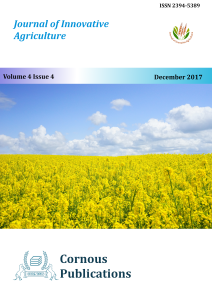
Journal of Innovative Agriculture
Peer Reviewed Open Access Journal
ISSN: 2394-5389 NAAS: 4.05
Submit Manuscript
Peer Reviewed Open Access Journal
ISSN: 2394-5389 NAAS: 4.05
Submit ManuscriptFarmers participatory research were conducted melon based cropping system with water melon and muskmelon in 20 hectare area during 2011-12 with an objective to study the water productivity and profitability of growing three melon crops under drip fertigation with polyethylene mulching. Field experiments were conducted at farmers field in Nolambur (Olakkur block and Vadanerkunam (Marakkanam block) Villupuram district of TamilNadu state. The results indicated that yield and quality characters of melons were significantly higher under drip fertigation coupled with mulching practice as compared to drip fertigation alone and or conventional irrigation method. In the first crop (watermelon) recorded highest fruit yield of 38.6 t ha-1 under drip fertigation coupled with polyethylene mulching (T3) as compared to either drip fertigation alone (T2) (31.1 t ha-1) and or farmer practice of furrow irrigation (T1) (21.8t ha-1). Similar trend was followed in second crop (Muskmelon) and third crop (Watermelon Ice box).In three-crop sequence, recorded highest cumulative fruit yield of 136t ha-1, which was 56 per cent yield advantage over the drip fertigation alone. In comparison with the conventional irrigation the yield advantage is more that 247per cent. The cumulative annual crop field analysis indicated that among the treatments drip fertigation combined with polyethylene mulching has increased the annual cost of production that increased the net profit to the maximum level of Rs. 7.59 lakhs ha-1.For the three crops 401 mm of water used under drip fertigation coupled with mulching, the saving was around 88.5 per cent over control and 34.8 per cent over drip fertigation alone.
Irrigation methods, drip fertigation, mulching, watermelon, muskmelon, cropping system
Al-Majali, M. A. and M. A. Kasrawi. 1995. Plastic mulch use and method of planting influences on rainfed muskmelon production. Pure and Applied Sci., 22(4): 1039-1054.
Andino, J. R. and C. E. Motsenbocker. 1998. Coloured plastic mulches influence cucumber beetle populations, vine growth and yield of watermelon. Hort. Sci., 39(6):1246-1249.
Ansary, S.H. and D.C. Roy. 2005. Effect of irrigation and mulching on growth, yield and quality of watermelon (Citrullus lanatus Thunb.). Environment and Ecology, 23(Spl-1): 141-143.
Arancibia, R. A. and C.E. Motsenbocker. 2008. Differential watermelon fruit size distribution in response to plastic mulch and spunbonded polyester rowcover. Hort.Tech., 18(1): 45-52.
Ban, D., K. Zanic, G. Dumicic, T.G. Culjak and S.G. Ban. 2004. The type of polythene mulch impacts vegetative growth, yield and aphid populations in watermelon production. Journal of Food, Agriculture & Environment, 7 (3-4): 543-550.
Battikhi, A.M. and I. Ghawi. 1987. Muskmelon production under mulch and trickle irrigation in the Jordan valley. Hort. Sci., 22(4): 578-581.
Bhella, H.S. 1988. Effect of trickle irrigation and black mulch on growth, yield and mineral composition of watermelon. Hort. Sci., 23(1):123-125.
Hallidri, M. 2001. Comparison of the different mulching materials on the growth, yield and quality of cucumber (Cucumis sativus L.). Acta Hort., 559: 49-54.
Hanna, H. Y. 2000. Black polyethylene mulch does not reduce yield of cucumbers double-cropped with tomatoes under heat stress. Hort. Sci., 35(2): 190-191.
Hartz, T.K. 1997. Effects of drip irrigation scheduling on muskmelon yield and quality. Sci. Hort., 69: 117-122.
Ibarra, L., J. Flores and J.C.D.P. Perez. 2001. Growth and response to plastic mulch and row covers. Scientia Horticulturae, 87(1/2): 139-145.
Ibarra-Jimenez, L., Gonzalez, A.Z., Lopez, J.M., Martin, M. A. R.Q. and M.D.L. Rosa-Ibarra. 2008. Photosynthesis, soil temperature and yield of cucumber as affected by colored plastic mulch. Acta Agriculturae Scandinavica Section B, Plant Soil Science, 58(4): 372-378.
Johnson J.M., J.A. Hough-Goldstein and M.J. Vangessel. 2000. Effects of Straw Mulch on Pest Insects, Predators, and Weeds in Watermelons and Potatoes. Environmental Entomology, 33: 1632-1643.
Panse, V.G. and P.V. Sukhatme. 1985. Statistical Methods for Agricultural Workers. Indian Council of Agricultural Research, New Delhi.p196.
Parmar, H. N., N. D. Polara and R.R. Viradiya. 2013. Effect of mulching material on growth, yield and quality of watermelon (Citrullus Lanatus Thunb) Cv. Kiran. Universal J. of Agric. Res., 1(2): 30-37.
Rani, R, Nirla, S.K. and R. Suresh. 2012. Effect of drip irrigation and mulch on pointed gourd in calcareous soil of north Bihar. Environment and Ecology. .30 (3): 641-645.
Rudich, J., Elassar, G. and Y. Shefi 1978. Optimal growth stages for the application of drip irrigation to muskmelon and watermelon. J. Hort. Sci., 53(1): 11-15.
Wang, Y., Z.K. Xie, F. Li and Z. Zhang. 2004. The effect of supplemental irrigation on Watermelon (Citrulus lanatus) production in gravel and sand mulched fields in the loess Plateau of northwest China. Agric. Water Manage., 69: 29-41.
